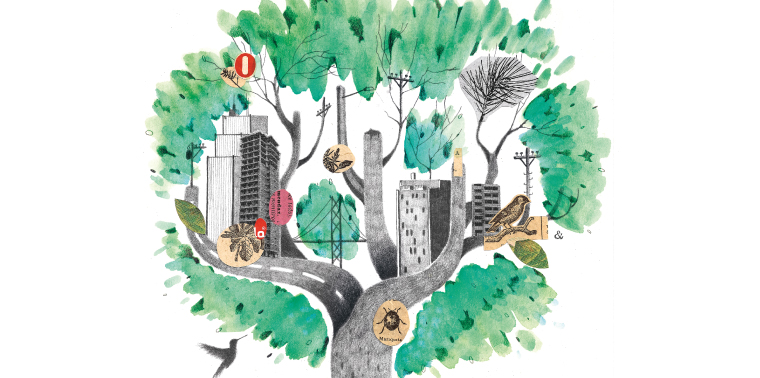More and more, biomimicry is being thought of as a way to reconsider the ways we build and operate cities. Today, these lessons are being actively applied in the realm of urban infrastructure and design in an effort to make places that are more sustainable, more livable, more intuitively designed and, at their core, more natural.
Lessons From Lavasa
To design roads the team looked to local anthills that are able to remain structurally sound during the region’s heavy rains.
About 60 miles (as the crow flies) southeast of Mumbai, India, the city of Lavasa is rising from the hills. With the guidance of Benyus and Biomimicry 3.8, Lavasa is being designed as a set of five small villages with populations between 30,000 and 50,000 people that will climb up the area’s steep slopes and mimic its dense forest. Benyus and her team have partnered with the architecture and planning firm HOK on the master plan for the second of the five villages, Mugaon. The plan and architecture are intended to create a sustainable framework for urban development in India, where the supply of housing is struggling to keep pace with the country’s swift urbanization.
Located in one of India’s monsoon hot spots, the hillside that will host Lavasa is subject to a short but intense rainy season that can see nearly 30 feet of rainfall in just three months, followed by months of drought. Despite all this water falling on steep hills, the area suffers almost no erosion and is able to use those water resources all year round.

Illustration by Samuel Castano
To understand how the hills stay intact, biologists from Biomimicry 3.8 studied the area’s ecosystem. Then they developed a set of “Genius of Place” design recommendations and ecological performance standards the city’s developers can use to ensure that whatever gets built performs at the same level as the natural environment. That means roofs that help re-release some of the monsoonal water back into the air as water vapor, pavement that allows water to permeate back into the ground and building foundations that grip the hillsides like the roots of trees. To design roads, for example, the team looked to local anthills that are able to remain structurally sound during the region’s heavy rains. The key, Benyus explains, is the anthills’ sinuosity, which channels and slows water as it runs over them. Lavasa’s roads are planned to mimic that characteristic.
Benyus and her team identified six “ecosystem services” provided by the area’s moist deciduous forest: water collection, solar gain, carbon sequestration, water filtration, evapotranspiration, and the cycling of nitrogen and phosphorus. Then they handed those to the planners and designers at HOK as guides for what their design would need to accomplish.
“They said in an ideal design solution, your new built environment would perform as if it were a moist deciduous forest,” says Mary Ann Lazarus, HOK’s director of sustainable design.
All Scales
Development in Lavasa has slowed recently due to some controversy over how the land was procured and how loans for construction were acquired, but Benyus says the model is sound. Biomimicry 3.8 is at work on similar projects in other places—especially China, where large-scale city building is occurring at an unprecedented rate. Biomimicry 3.8 and HOK, for example, drafted a master plan for Langfang, a city of about 4 million that’s part of the North China Plain’s Beijing-Tianjin mega-region. The plan seeks to counteract the drought and land subsidence the city has suffered due to unsustainable agriculture by implementing a wetland mimicry scenario.
Lazarus says HOK has integrated biomimetic thinking into its design work at all scales around the world. Some of the firm’s designers have even completed Biomimicry 3.8’s intense certification program on biomimicry thinking. In addition, they’ve developed a system of natural strategies based on each of 18 “biome regions” to guide projects when they can’t pull in the formal Biomimicry 3.8 team.
Ensia shares solutions-focused stories free of charge through our online magazine and partner media. That means audiences around the world have ready access to stories that can — and do — help them shape a better future. If you value our work, please show your support today.
Yes, I'll support Ensia!

Have read a tiny bit about bio-mimicry in the past, but nice to learn more about how it's developing in the here and now.
Thanks!
Dr. Korkmaz would be a great asset to get as a professor at a US University.
Another example of biomimetic thinking applied to urban planning is the emerging field of "urban metabolism" -- which looks at the flows of water, waste, and other nutrients through urban ecosystems. A great application of this approach is the design of Lloyd Crossing by Mithun Architects Designers + Planners, in which the design team compared flows of water, carbon, etc. against a "pre-development baseline."
My colleague Lyle Solla-Yates and I have also used this approach in our research, for instance investigating the impact of alternative waste management systems: http://www.carlsterner.com/research/2010_toward_the_green_city.shtml